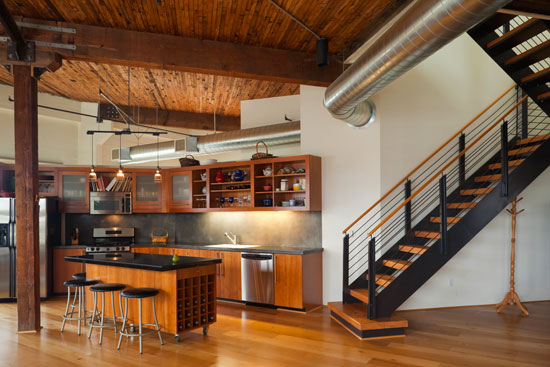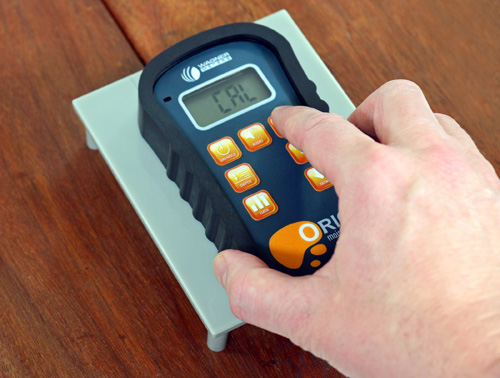Wood Moisture and What You Can Do About It
Previously published by Construction Canada
 Wood is an exceptionally versatile and attractive building material that has been used in construction for literally thousands of years. Wood’s advantages in construction are many. It is extremely strong in relation to its weight. It is also widely available and is economically competitive with other types of building materials. And it is durable, reusable, and carries the lowest carbon footprint of any comparable building material.
Wood is an exceptionally versatile and attractive building material that has been used in construction for literally thousands of years. Wood’s advantages in construction are many. It is extremely strong in relation to its weight. It is also widely available and is economically competitive with other types of building materials. And it is durable, reusable, and carries the lowest carbon footprint of any comparable building material.
Wood can be used for nearly any facet of a building project, including floors, walls, ceilings, panels, cabinets, doors, window frames, and structural support. Indeed, it can be fabricated into a variety of different shapes and sizes to fit practically any construction need.
For wood to satisfactorily fulfill its intended purpose in a building project, one must keep in mind that wood is susceptible to the influence of moisture in the environment. Wood is a hygroscopic material, meaning that it has the ability to absorb or lose moisture depending on the relative humidity (RH) and temperature conditions of the surrounding environment. In simple terms, when wood absorbs moisture from the environment, it tends to expand. When wood loses moisture, it tends to shrink.
Due to its swelling and shrinking tendencies, wood can incur significant moisture-related damage. Problems due to moisture can rear their ugly heads in different ways. Warping, which is any deviation from flatness, is a common issue that can occur when wood takes up moisture unevenly or is allowed to dry too slowly or too quickly.
Warping can take several forms:
- Bow: a warp along the length of the face of the wood.
- Crook: a warp along the length of the edge of the wood.
- Cup: a warp along the width in which the edges of the wood are higher or lower than the center.
- Twist: a distortion in which the two ends do not lie on the same plane.
Aside from the undesirable appearance, warping can also lead to costly structural failures. For example, in wood flooring, an issue with cupping may create gaps between the boards. Eventually, if the boards do not revert to their original shape, they could separate away from the subfloor, or even splinter or crack.
Moisture may cause other types of issues that impair the quality, appearance, and performance of the wood.
Buckling is an extreme reaction to moisture that typically occurs in response to prolonged exposure to excess moisture. With wood flooring, buckling is what happens when the flooring gets pulled up from the subfloor, lifting as much as several inches in one or more places. Fortunately, buckling is not a common occurrence, and if caught early, spot repair and replacement may be possible.
Mold and mildew may grow on wood surfaces when the surrounding environment is damp or poorly ventilated. Aside from causing unsightly black, blue, or greenish-brown patches, spores from molds may cause allergy issues or other serious health concerns. While molds contribute to discoloration or staining, they are not usually a factor in any structural damage to the wood.
Wood decay or rot is another serious moisture-related issue. It is caused by specific fungi that can grow in moist wood and destroy the wood fibers, leading to structural damage. The spores of decay fungi are always present in the air. As such, they cannot be kept away from wood. However, fungi can generally grow in wood only when the wood’s moisture content (MC) is greater than 20 percent. Preventing decay is straightforward assuming wood is kept below this moisture threshold.
How Wood Holds Moisture
Wood’s hygroscopic nature stems from its individual cells which are designed to soak up moisture that a living tree needs as it grows and matures. Those cells don’t lose their capacity to hold and release moisture once the tree is converted into usable lumber.
The cells hold moisture in two ways:
- Free water, in which the cell cavities can hold moisture in both its liquid and vapor states.
- Bound water, in which the cell walls, made up of cellulose fibers called microfibrils, hold water that is chemically bonded or essentially “bound” with the cellulose molecules.
The amount of water in the wood, or the MC percentage (MC%), is the combined total of both free and bound water. However, these two forms of water do not impact wood in the same way. It is the movement of bound water either into or out of the wood that has the most significant impact on whether the wood is warping, swelling, shrinking or cracking.
The cell walls will expand or shrink depending on the amount of water they hold. In contrast, cells holding free water do not virtually change their shape with any shift in MC in the cell cavities and open spaces. However, free water usually occurs at moisture levels much higher than is used in construction.
The Effect of Ambient Temperature and RH
Ambient conditions (temperature and RH) largely dictate whether the wood cells take on or release moisture. Air temperature affects the amount of moisture that air can hold. Warmer air can hold more moisture than colder air. RH indicates how much moisture the air is holding as a percentage of what it could hold.
Wood absorbs or releases moisture in response to ambient RH. When the ambient RH is low relative to the MC of the wood, moisture gets drawn out of the wood. When RH is high relative to the wood’s moisture level, the wood will suck moisture from the environment.
Wood reaches a point of equilibrium moisture content (EMC) when it is neither absorbing nor releasing moisture. Attaining EMC requires relatively stable ambient conditions so that the moisture within the wood can eventually match its surroundings. When ambient conditions are constantly changing, so will the MC of the wood.
In construction projects, it is important to work with wood that has been dried to the proper MC and has attained the point of EMC. Inside heated buildings, this will often mean aiming for an MC of about six to eight percent, although this is merely a rule of thumb that may vary according to different environmental conditions and the geographic location.
How to Measure Wood MC
Though other methods exist, the simplest and fastest way to get an accurate measurement of wood’s MC is to use a handheld moisture meter. Two types are available: (1) resistance or pin-style and (2) dielectric or pinless meters.
When using a pin meter, two pins are inserted into the wood and the meter measures the electrical resistance between the pins. Since moisture conducts electricity, higher electrical resistance corresponds with drier wood, and conversely, lower electrical resistance corresponds with wetter wood. One drawback to pin meters is that they are intrusive, leaving unsightly pin holes in the wood. Another drawback is that they can be somewhat slow and cumbersome to use. This is especially true with hardwoods, where inserting pins to the depth necessary for an accurate reading can prove difficult.
In contrast, pinless moisture meters are extremely fast to use. Because they employ a flat plate in contact with the wood surface to detect conductivity using electromagnetic waves, they leave no damaging holes in the wood. They can also be used for a broader range of MC measurements than most pin-style meters. One drawback of pinless meters is that some of them may be unduly affected by surface moisture or ambient temperature.
Because pinless meters are fast and easy to use, they provide an excellent way of monitoring wood moisture levels in just about any construction or remedial application. During construction, they can be used for assessing when wood materials are ready for installation, such as in a hardwood flooring application. In an existing building, they can be used to detect small trouble spots and help contain moisture-related problems before they grow totally out of hand. Handheld meters can also be used to determine quickly and easily the extent of existing moisture that might cause damage.
Keep in mind that it can be useful to monitor more than just the moisture in the wood.
Given that ambient conditions play such an important role in how wood is affected by moisture, it can be extremely helpful to monitor ambient temperature and RH at any job site or building where wood materials are used. Portable data logging devices make great tools for taking temperature and RH measurements 24/7.

Free Download – 5 Ways Pinless Moisture Meters Save You Time and Money
Today’s Advanced Moisture Measurement Technology
Newer meter technology now makes the monitoring of onsite moisture conditions easier and more accurate than ever. For example, the new Orion line of pinless moisture meters from Wagner Meters is engineered to take measurements at specified depths, which minimizes any effect from surface moisture and ensures more accurate results. The Orion 950 is an especially powerful device that provides accurate wood moisture measurements AND measures ambient temperature and RH.

In-the-field calibration of the Orion 950 Smart Pinless Moisture Meter. A capability exclusive only to the Orion line of wood moisture meters.
Another recent advance in pinless meter technology is the ability to do true in-field calibration of meters. Most handheld meters, whether pin or pinless, must be sent back to the manufacturer for recalibration. But Wagner’s Orion meters offer the convenience of true on-site calibration to help ensure accuracy with every measurement.
While some of today’s most versatile wood moisture meters, such as the Orion 950, can measure ambient temperature and RH, they do so only when one is actually onsite using the device and taking measurements.
Obtaining Ambient Temperature and RH Data 24/7
A growing number of people in the construction industry are taking advantage of today’s portable data loggers that capture temperature and RH data around the clock, even when no one is there to collect the data. The new Smart Logger by Wagner Meters, for example, is a relatively tiny, unobtrusive device that can readily be installed and left in any spot where one suspects ambient conditions could be a factor leading to moisture damage, mold or mildew growth, or other similar issues.
These data logging devices are useful in a wide variety of residential and commercial settings, including hospitals, schools, businesses, and government buildings. They save time and money by reducing the number of site visits needed for monitoring ambient conditions. They can also serve as a valuable reminder to customers and clients to maintain consistent, optimal conditions in the building or project area.
In today’s construction world, in which we know so much about moisture-related issues and their causes and effects, it clearly makes sense to take advantage of highly advanced wood moisture meters and data logging tools that are capable of giving a fast, easy and accurate picture of conditions in wood and the surrounding environment. Indeed, it’s really the only practical way one can get a handle on what’s happening so that the significant expense and headache of wood moisture problems can be prevented or minimized.
For more information about the effects of moisture in wood, and the best methods and tools for moisture measurement, call Wagner Meters at 541-291-5124.
References
Glass, S., and Zelinka. Samuel. Moisture relations and physical properties of wood. https://www.fpl.fs.fed.us/documnts/fplgtr/fplgtr190/chapter_04.pdf
LSU Ag Center Research and Extension. Causes and control of wood decay, degradation and stain. https://www.fpl.fs.fed.us/documnts/pdf2008/fpl_2008_shupe001.pdf
Reeb, J.E. Wood and moisture relationships. https://ir.library.oregonstate.edu/downloads/td96k297v?locale=en
Jason has 20+ years’ experience in sales and sales management in a spectrum of industries and has successfully launched a variety of products to the market, including the original Rapid RH® concrete moisture tests. He currently works with Wagner Meters as our Rapid RH® product sales manager.
Related Posts via Taxonomies
Last updated on August 18th, 2022



